Educational Attainment of Black Children in the UK
VerifiedAdded on 2022/12/22
|8
|2905
|1
Essay
AI Summary
This essay delves into the complexities of educational attainment among Black children, focusing on secondary education in the UK. It explores the statistical disparities in achievement and exclusion rates, examining how factors like ethnicity, labelling, and self-fulfilling prophecies impact student outcomes. The essay also investigates the roles of poverty, cultural capital, and intersectionality in perpetuating educational inequalities. By analyzing statistical data and relevant research, the essay highlights the challenges faced by Black students, from institutional racism and teacher expectations to family backgrounds and societal pressures. The discussion includes an overview of GCSE results, the impact of IQ tests and genetic factors, and the influence of cultural capital. The essay considers the influence of schools, social class, and discrimination on attainment, and it touches upon the role of family and early marriage in shaping educational outcomes. The essay concludes by emphasizing the importance of understanding these multifaceted issues to promote social justice and improve educational opportunities for Black children.
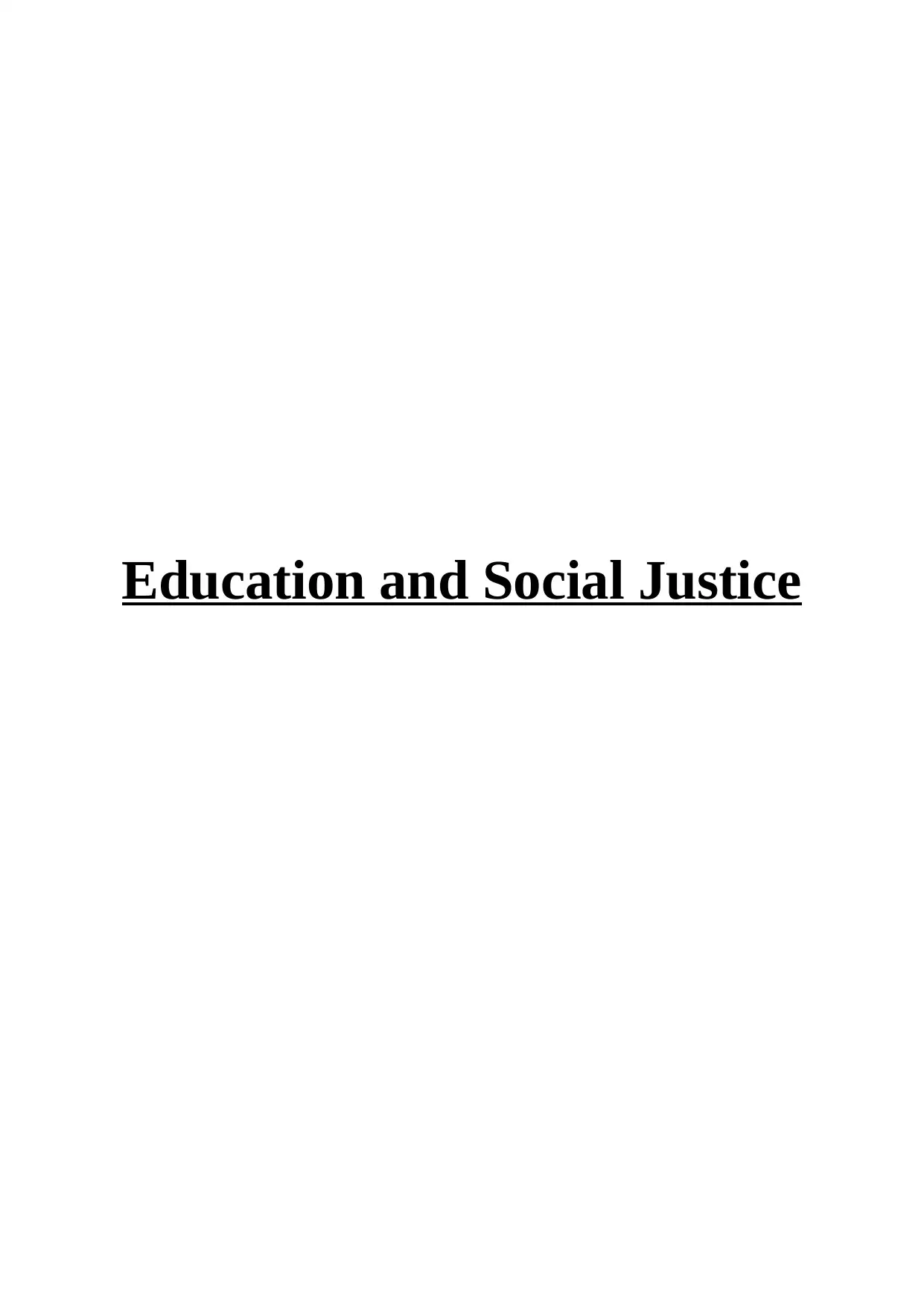
Education and Social Justice
Paraphrase This Document
Need a fresh take? Get an instant paraphrase of this document with our AI Paraphraser
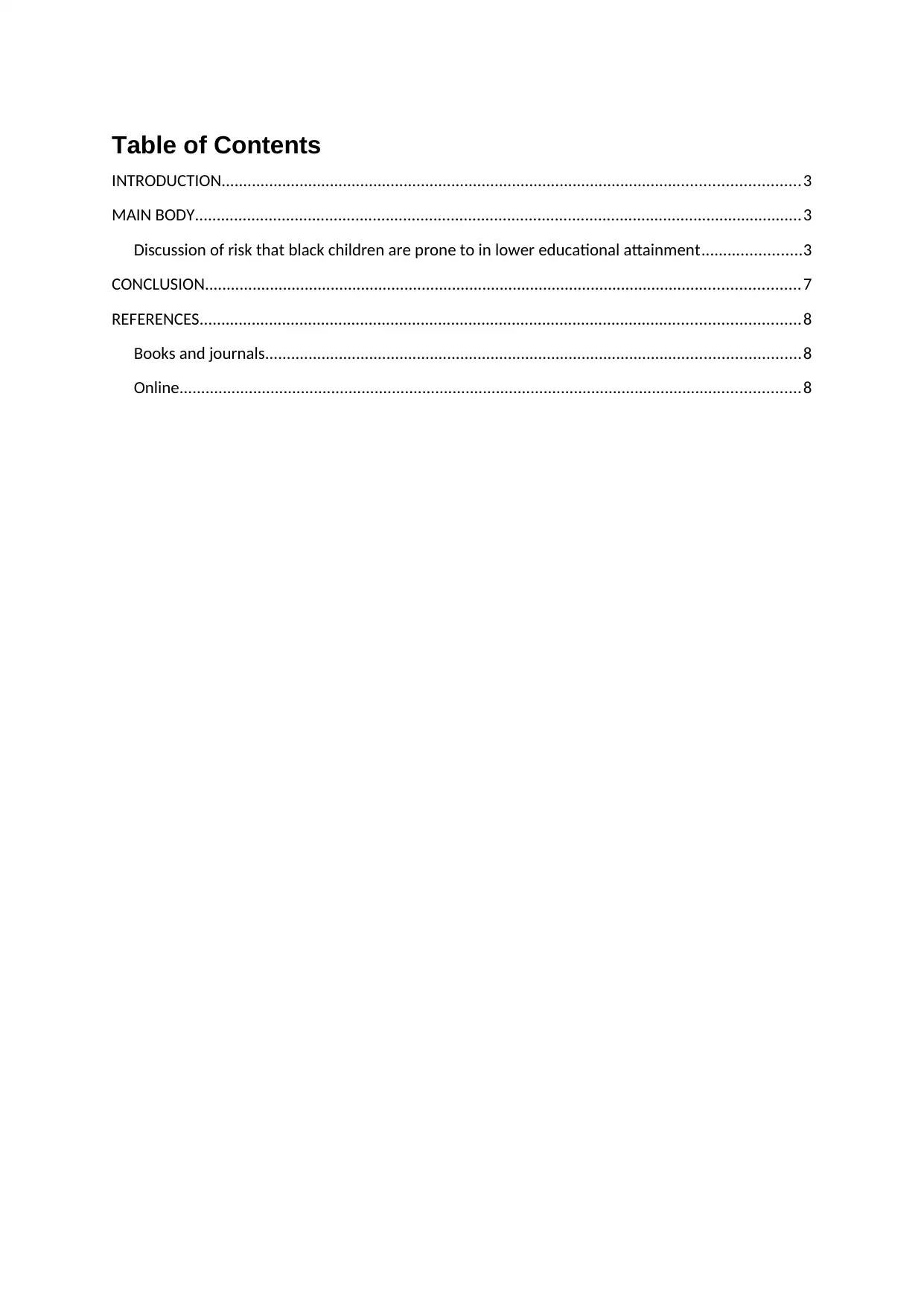
Table of Contents
INTRODUCTION.....................................................................................................................................3
MAIN BODY............................................................................................................................................3
Discussion of risk that black children are prone to in lower educational attainment.......................3
CONCLUSION.........................................................................................................................................7
REFERENCES..........................................................................................................................................8
Books and journals...........................................................................................................................8
Online...............................................................................................................................................8
INTRODUCTION.....................................................................................................................................3
MAIN BODY............................................................................................................................................3
Discussion of risk that black children are prone to in lower educational attainment.......................3
CONCLUSION.........................................................................................................................................7
REFERENCES..........................................................................................................................................8
Books and journals...........................................................................................................................8
Online...............................................................................................................................................8
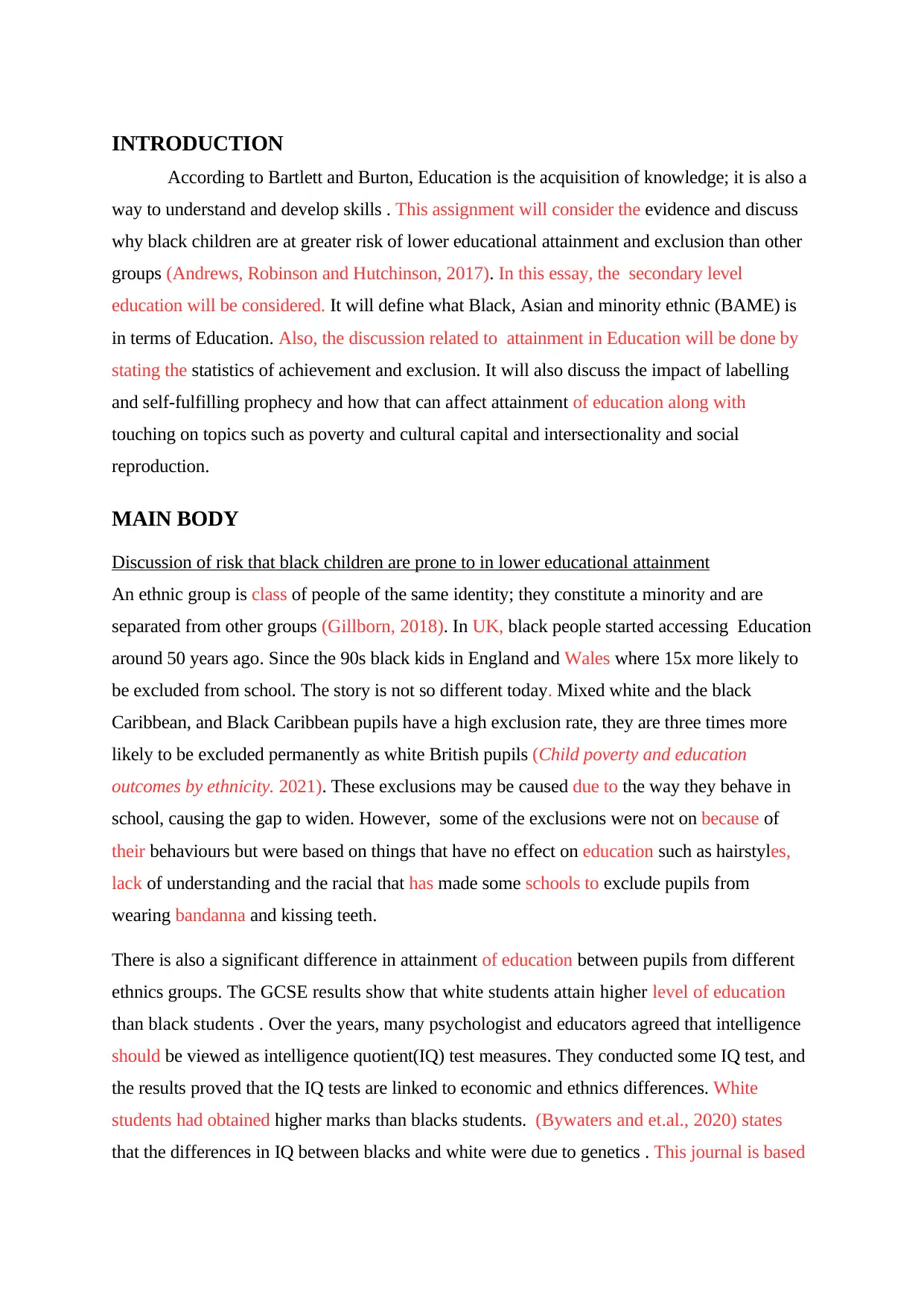
INTRODUCTION
According to Bartlett and Burton, Education is the acquisition of knowledge; it is also a
way to understand and develop skills . This assignment will consider the evidence and discuss
why black children are at greater risk of lower educational attainment and exclusion than other
groups (Andrews, Robinson and Hutchinson, 2017). In this essay, the secondary level
education will be considered. It will define what Black, Asian and minority ethnic (BAME) is
in terms of Education. Also, the discussion related to attainment in Education will be done by
stating the statistics of achievement and exclusion. It will also discuss the impact of labelling
and self-fulfilling prophecy and how that can affect attainment of education along with
touching on topics such as poverty and cultural capital and intersectionality and social
reproduction.
MAIN BODY
Discussion of risk that black children are prone to in lower educational attainment
An ethnic group is class of people of the same identity; they constitute a minority and are
separated from other groups (Gillborn, 2018). In UK, black people started accessing Education
around 50 years ago. Since the 90s black kids in England and Wales where 15x more likely to
be excluded from school. The story is not so different today. Mixed white and the black
Caribbean, and Black Caribbean pupils have a high exclusion rate, they are three times more
likely to be excluded permanently as white British pupils (Child poverty and education
outcomes by ethnicity. 2021). These exclusions may be caused due to the way they behave in
school, causing the gap to widen. However, some of the exclusions were not on because of
their behaviours but were based on things that have no effect on education such as hairstyles,
lack of understanding and the racial that has made some schools to exclude pupils from
wearing bandanna and kissing teeth.
There is also a significant difference in attainment of education between pupils from different
ethnics groups. The GCSE results show that white students attain higher level of education
than black students . Over the years, many psychologist and educators agreed that intelligence
should be viewed as intelligence quotient(IQ) test measures. They conducted some IQ test, and
the results proved that the IQ tests are linked to economic and ethnics differences. White
students had obtained higher marks than blacks students. (Bywaters and et.al., 2020) states
that the differences in IQ between blacks and white were due to genetics . This journal is based
According to Bartlett and Burton, Education is the acquisition of knowledge; it is also a
way to understand and develop skills . This assignment will consider the evidence and discuss
why black children are at greater risk of lower educational attainment and exclusion than other
groups (Andrews, Robinson and Hutchinson, 2017). In this essay, the secondary level
education will be considered. It will define what Black, Asian and minority ethnic (BAME) is
in terms of Education. Also, the discussion related to attainment in Education will be done by
stating the statistics of achievement and exclusion. It will also discuss the impact of labelling
and self-fulfilling prophecy and how that can affect attainment of education along with
touching on topics such as poverty and cultural capital and intersectionality and social
reproduction.
MAIN BODY
Discussion of risk that black children are prone to in lower educational attainment
An ethnic group is class of people of the same identity; they constitute a minority and are
separated from other groups (Gillborn, 2018). In UK, black people started accessing Education
around 50 years ago. Since the 90s black kids in England and Wales where 15x more likely to
be excluded from school. The story is not so different today. Mixed white and the black
Caribbean, and Black Caribbean pupils have a high exclusion rate, they are three times more
likely to be excluded permanently as white British pupils (Child poverty and education
outcomes by ethnicity. 2021). These exclusions may be caused due to the way they behave in
school, causing the gap to widen. However, some of the exclusions were not on because of
their behaviours but were based on things that have no effect on education such as hairstyles,
lack of understanding and the racial that has made some schools to exclude pupils from
wearing bandanna and kissing teeth.
There is also a significant difference in attainment of education between pupils from different
ethnics groups. The GCSE results show that white students attain higher level of education
than black students . Over the years, many psychologist and educators agreed that intelligence
should be viewed as intelligence quotient(IQ) test measures. They conducted some IQ test, and
the results proved that the IQ tests are linked to economic and ethnics differences. White
students had obtained higher marks than blacks students. (Bywaters and et.al., 2020) states
that the differences in IQ between blacks and white were due to genetics . This journal is based
⊘ This is a preview!⊘
Do you want full access?
Subscribe today to unlock all pages.

Trusted by 1+ million students worldwide
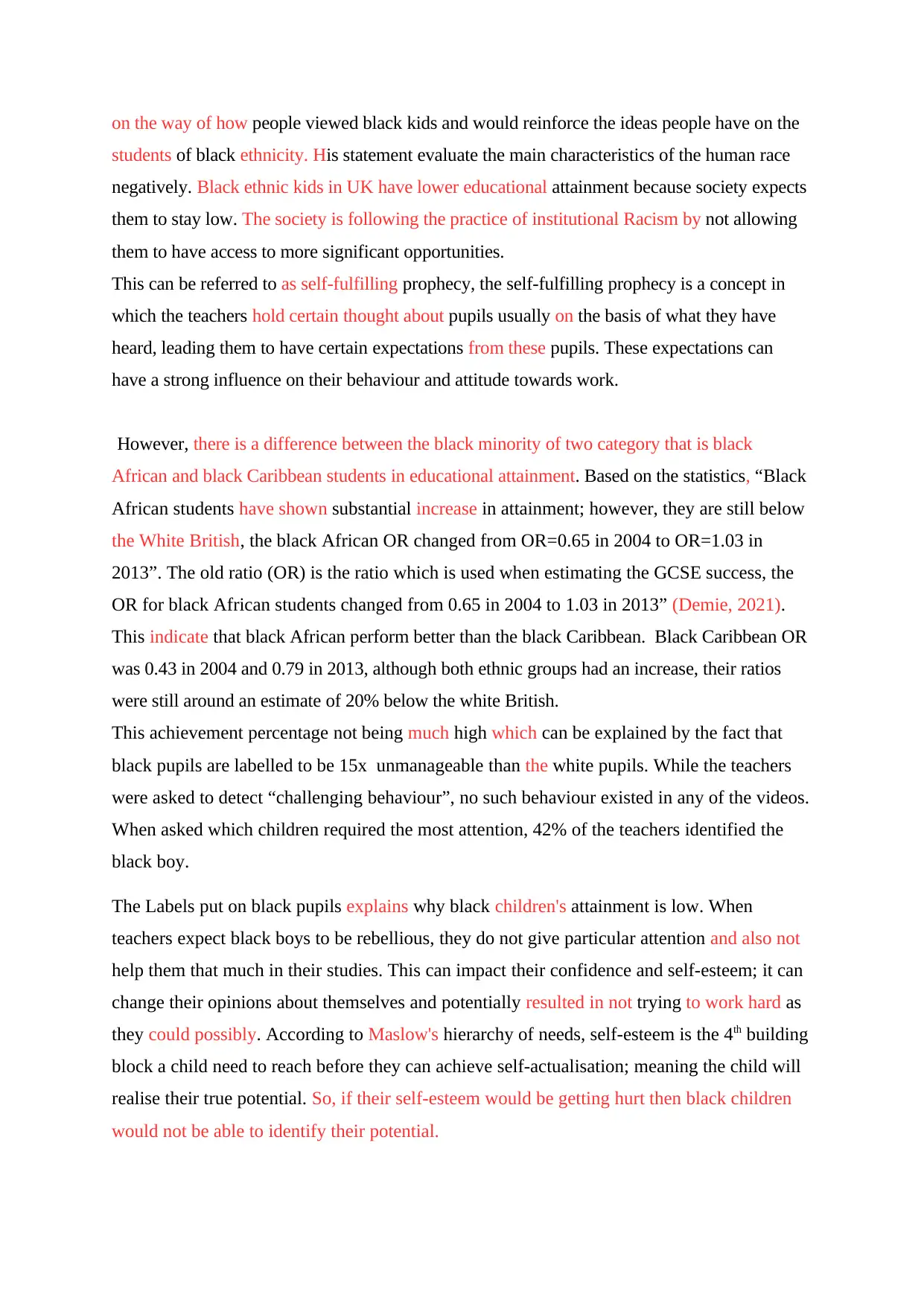
on the way of how people viewed black kids and would reinforce the ideas people have on the
students of black ethnicity. His statement evaluate the main characteristics of the human race
negatively. Black ethnic kids in UK have lower educational attainment because society expects
them to stay low. The society is following the practice of institutional Racism by not allowing
them to have access to more significant opportunities.
This can be referred to as self-fulfilling prophecy, the self-fulfilling prophecy is a concept in
which the teachers hold certain thought about pupils usually on the basis of what they have
heard, leading them to have certain expectations from these pupils. These expectations can
have a strong influence on their behaviour and attitude towards work.
However, there is a difference between the black minority of two category that is black
African and black Caribbean students in educational attainment. Based on the statistics, “Black
African students have shown substantial increase in attainment; however, they are still below
the White British, the black African OR changed from OR=0.65 in 2004 to OR=1.03 in
2013”. The old ratio (OR) is the ratio which is used when estimating the GCSE success, the
OR for black African students changed from 0.65 in 2004 to 1.03 in 2013” (Demie, 2021).
This indicate that black African perform better than the black Caribbean. Black Caribbean OR
was 0.43 in 2004 and 0.79 in 2013, although both ethnic groups had an increase, their ratios
were still around an estimate of 20% below the white British.
This achievement percentage not being much high which can be explained by the fact that
black pupils are labelled to be 15x unmanageable than the white pupils. While the teachers
were asked to detect “challenging behaviour”, no such behaviour existed in any of the videos.
When asked which children required the most attention, 42% of the teachers identified the
black boy.
The Labels put on black pupils explains why black children's attainment is low. When
teachers expect black boys to be rebellious, they do not give particular attention and also not
help them that much in their studies. This can impact their confidence and self-esteem; it can
change their opinions about themselves and potentially resulted in not trying to work hard as
they could possibly. According to Maslow's hierarchy of needs, self-esteem is the 4th building
block a child need to reach before they can achieve self-actualisation; meaning the child will
realise their true potential. So, if their self-esteem would be getting hurt then black children
would not be able to identify their potential.
students of black ethnicity. His statement evaluate the main characteristics of the human race
negatively. Black ethnic kids in UK have lower educational attainment because society expects
them to stay low. The society is following the practice of institutional Racism by not allowing
them to have access to more significant opportunities.
This can be referred to as self-fulfilling prophecy, the self-fulfilling prophecy is a concept in
which the teachers hold certain thought about pupils usually on the basis of what they have
heard, leading them to have certain expectations from these pupils. These expectations can
have a strong influence on their behaviour and attitude towards work.
However, there is a difference between the black minority of two category that is black
African and black Caribbean students in educational attainment. Based on the statistics, “Black
African students have shown substantial increase in attainment; however, they are still below
the White British, the black African OR changed from OR=0.65 in 2004 to OR=1.03 in
2013”. The old ratio (OR) is the ratio which is used when estimating the GCSE success, the
OR for black African students changed from 0.65 in 2004 to 1.03 in 2013” (Demie, 2021).
This indicate that black African perform better than the black Caribbean. Black Caribbean OR
was 0.43 in 2004 and 0.79 in 2013, although both ethnic groups had an increase, their ratios
were still around an estimate of 20% below the white British.
This achievement percentage not being much high which can be explained by the fact that
black pupils are labelled to be 15x unmanageable than the white pupils. While the teachers
were asked to detect “challenging behaviour”, no such behaviour existed in any of the videos.
When asked which children required the most attention, 42% of the teachers identified the
black boy.
The Labels put on black pupils explains why black children's attainment is low. When
teachers expect black boys to be rebellious, they do not give particular attention and also not
help them that much in their studies. This can impact their confidence and self-esteem; it can
change their opinions about themselves and potentially resulted in not trying to work hard as
they could possibly. According to Maslow's hierarchy of needs, self-esteem is the 4th building
block a child need to reach before they can achieve self-actualisation; meaning the child will
realise their true potential. So, if their self-esteem would be getting hurt then black children
would not be able to identify their potential.
Paraphrase This Document
Need a fresh take? Get an instant paraphrase of this document with our AI Paraphraser
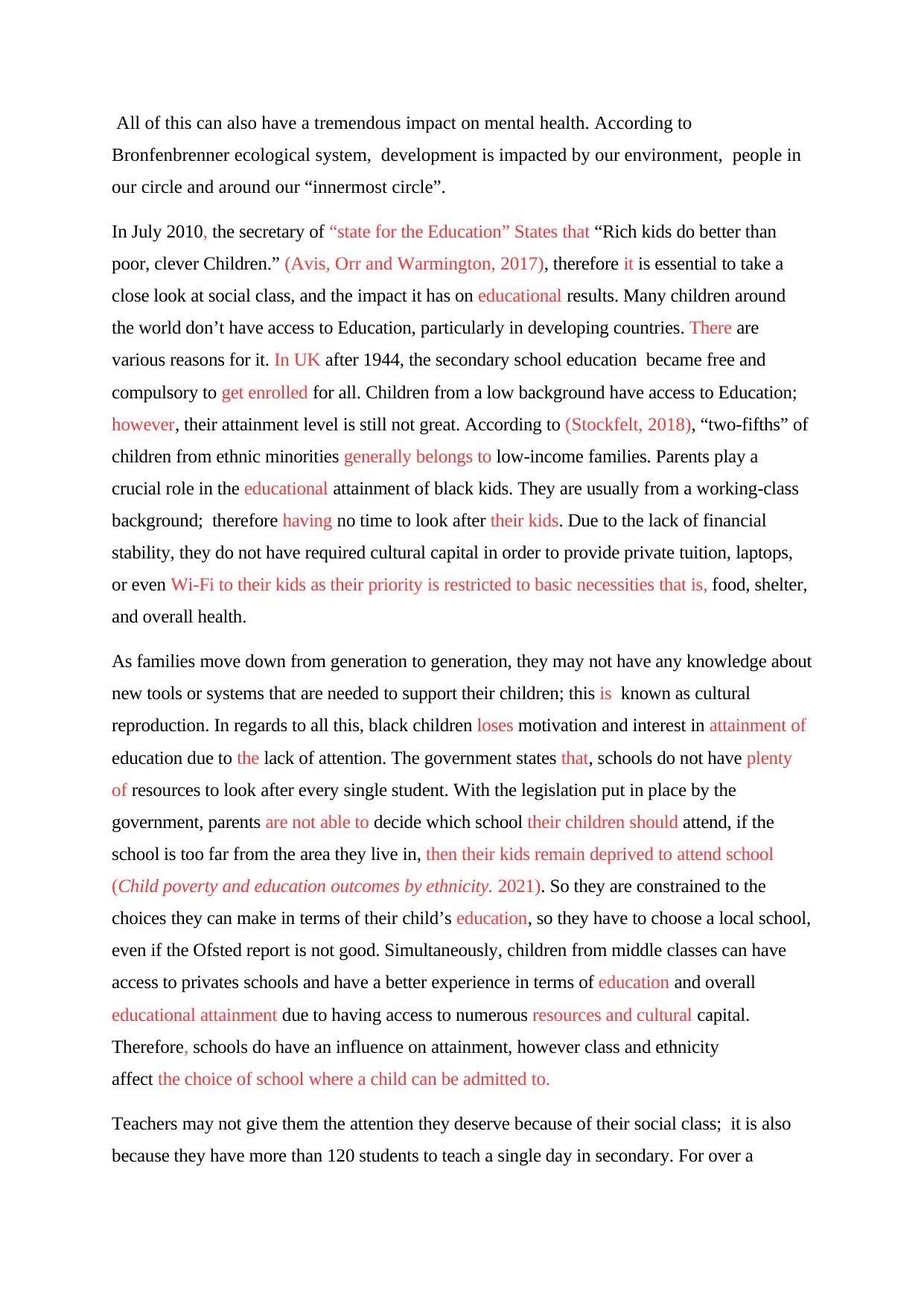
All of this can also have a tremendous impact on mental health. According to
Bronfenbrenner ecological system, development is impacted by our environment, people in
our circle and around our “innermost circle”.
In July 2010, the secretary of “state for the Education” States that “Rich kids do better than
poor, clever Children.” (Avis, Orr and Warmington, 2017), therefore it is essential to take a
close look at social class, and the impact it has on educational results. Many children around
the world don’t have access to Education, particularly in developing countries. There are
various reasons for it. In UK after 1944, the secondary school education became free and
compulsory to get enrolled for all. Children from a low background have access to Education;
however, their attainment level is still not great. According to (Stockfelt, 2018), “two-fifths” of
children from ethnic minorities generally belongs to low-income families. Parents play a
crucial role in the educational attainment of black kids. They are usually from a working-class
background; therefore having no time to look after their kids. Due to the lack of financial
stability, they do not have required cultural capital in order to provide private tuition, laptops,
or even Wi-Fi to their kids as their priority is restricted to basic necessities that is, food, shelter,
and overall health.
As families move down from generation to generation, they may not have any knowledge about
new tools or systems that are needed to support their children; this is known as cultural
reproduction. In regards to all this, black children loses motivation and interest in attainment of
education due to the lack of attention. The government states that, schools do not have plenty
of resources to look after every single student. With the legislation put in place by the
government, parents are not able to decide which school their children should attend, if the
school is too far from the area they live in, then their kids remain deprived to attend school
(Child poverty and education outcomes by ethnicity. 2021). So they are constrained to the
choices they can make in terms of their child’s education, so they have to choose a local school,
even if the Ofsted report is not good. Simultaneously, children from middle classes can have
access to privates schools and have a better experience in terms of education and overall
educational attainment due to having access to numerous resources and cultural capital.
Therefore, schools do have an influence on attainment, however class and ethnicity
affect the choice of school where a child can be admitted to.
Teachers may not give them the attention they deserve because of their social class; it is also
because they have more than 120 students to teach a single day in secondary. For over a
Bronfenbrenner ecological system, development is impacted by our environment, people in
our circle and around our “innermost circle”.
In July 2010, the secretary of “state for the Education” States that “Rich kids do better than
poor, clever Children.” (Avis, Orr and Warmington, 2017), therefore it is essential to take a
close look at social class, and the impact it has on educational results. Many children around
the world don’t have access to Education, particularly in developing countries. There are
various reasons for it. In UK after 1944, the secondary school education became free and
compulsory to get enrolled for all. Children from a low background have access to Education;
however, their attainment level is still not great. According to (Stockfelt, 2018), “two-fifths” of
children from ethnic minorities generally belongs to low-income families. Parents play a
crucial role in the educational attainment of black kids. They are usually from a working-class
background; therefore having no time to look after their kids. Due to the lack of financial
stability, they do not have required cultural capital in order to provide private tuition, laptops,
or even Wi-Fi to their kids as their priority is restricted to basic necessities that is, food, shelter,
and overall health.
As families move down from generation to generation, they may not have any knowledge about
new tools or systems that are needed to support their children; this is known as cultural
reproduction. In regards to all this, black children loses motivation and interest in attainment of
education due to the lack of attention. The government states that, schools do not have plenty
of resources to look after every single student. With the legislation put in place by the
government, parents are not able to decide which school their children should attend, if the
school is too far from the area they live in, then their kids remain deprived to attend school
(Child poverty and education outcomes by ethnicity. 2021). So they are constrained to the
choices they can make in terms of their child’s education, so they have to choose a local school,
even if the Ofsted report is not good. Simultaneously, children from middle classes can have
access to privates schools and have a better experience in terms of education and overall
educational attainment due to having access to numerous resources and cultural capital.
Therefore, schools do have an influence on attainment, however class and ethnicity
affect the choice of school where a child can be admitted to.
Teachers may not give them the attention they deserve because of their social class; it is also
because they have more than 120 students to teach a single day in secondary. For over a
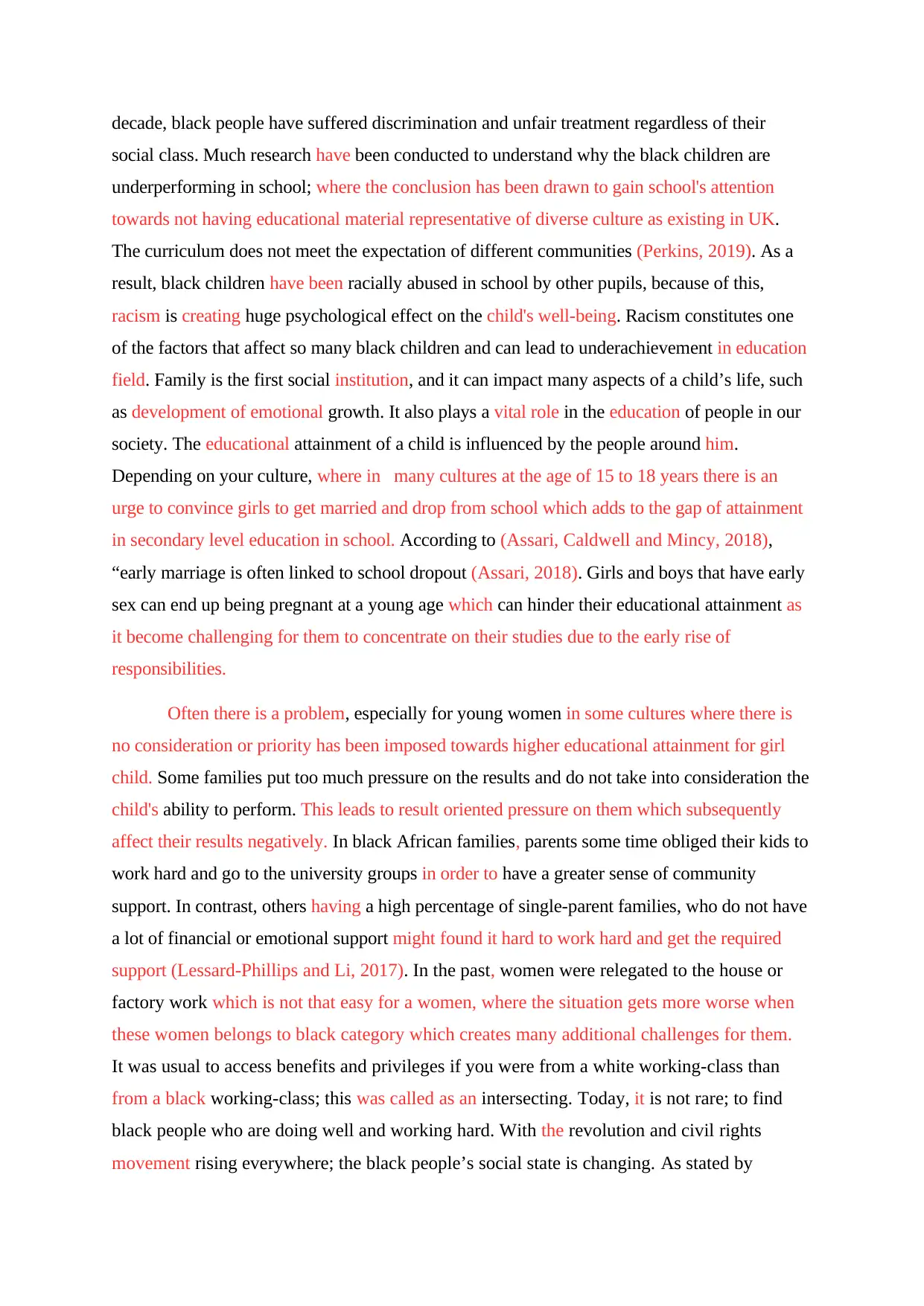
decade, black people have suffered discrimination and unfair treatment regardless of their
social class. Much research have been conducted to understand why the black children are
underperforming in school; where the conclusion has been drawn to gain school's attention
towards not having educational material representative of diverse culture as existing in UK.
The curriculum does not meet the expectation of different communities (Perkins, 2019). As a
result, black children have been racially abused in school by other pupils, because of this,
racism is creating huge psychological effect on the child's well-being. Racism constitutes one
of the factors that affect so many black children and can lead to underachievement in education
field. Family is the first social institution, and it can impact many aspects of a child’s life, such
as development of emotional growth. It also plays a vital role in the education of people in our
society. The educational attainment of a child is influenced by the people around him.
Depending on your culture, where in many cultures at the age of 15 to 18 years there is an
urge to convince girls to get married and drop from school which adds to the gap of attainment
in secondary level education in school. According to (Assari, Caldwell and Mincy, 2018),
“early marriage is often linked to school dropout (Assari, 2018). Girls and boys that have early
sex can end up being pregnant at a young age which can hinder their educational attainment as
it become challenging for them to concentrate on their studies due to the early rise of
responsibilities.
Often there is a problem, especially for young women in some cultures where there is
no consideration or priority has been imposed towards higher educational attainment for girl
child. Some families put too much pressure on the results and do not take into consideration the
child's ability to perform. This leads to result oriented pressure on them which subsequently
affect their results negatively. In black African families, parents some time obliged their kids to
work hard and go to the university groups in order to have a greater sense of community
support. In contrast, others having a high percentage of single-parent families, who do not have
a lot of financial or emotional support might found it hard to work hard and get the required
support (Lessard-Phillips and Li, 2017). In the past, women were relegated to the house or
factory work which is not that easy for a women, where the situation gets more worse when
these women belongs to black category which creates many additional challenges for them.
It was usual to access benefits and privileges if you were from a white working-class than
from a black working-class; this was called as an intersecting. Today, it is not rare; to find
black people who are doing well and working hard. With the revolution and civil rights
movement rising everywhere; the black people’s social state is changing. As stated by
social class. Much research have been conducted to understand why the black children are
underperforming in school; where the conclusion has been drawn to gain school's attention
towards not having educational material representative of diverse culture as existing in UK.
The curriculum does not meet the expectation of different communities (Perkins, 2019). As a
result, black children have been racially abused in school by other pupils, because of this,
racism is creating huge psychological effect on the child's well-being. Racism constitutes one
of the factors that affect so many black children and can lead to underachievement in education
field. Family is the first social institution, and it can impact many aspects of a child’s life, such
as development of emotional growth. It also plays a vital role in the education of people in our
society. The educational attainment of a child is influenced by the people around him.
Depending on your culture, where in many cultures at the age of 15 to 18 years there is an
urge to convince girls to get married and drop from school which adds to the gap of attainment
in secondary level education in school. According to (Assari, Caldwell and Mincy, 2018),
“early marriage is often linked to school dropout (Assari, 2018). Girls and boys that have early
sex can end up being pregnant at a young age which can hinder their educational attainment as
it become challenging for them to concentrate on their studies due to the early rise of
responsibilities.
Often there is a problem, especially for young women in some cultures where there is
no consideration or priority has been imposed towards higher educational attainment for girl
child. Some families put too much pressure on the results and do not take into consideration the
child's ability to perform. This leads to result oriented pressure on them which subsequently
affect their results negatively. In black African families, parents some time obliged their kids to
work hard and go to the university groups in order to have a greater sense of community
support. In contrast, others having a high percentage of single-parent families, who do not have
a lot of financial or emotional support might found it hard to work hard and get the required
support (Lessard-Phillips and Li, 2017). In the past, women were relegated to the house or
factory work which is not that easy for a women, where the situation gets more worse when
these women belongs to black category which creates many additional challenges for them.
It was usual to access benefits and privileges if you were from a white working-class than
from a black working-class; this was called as an intersecting. Today, it is not rare; to find
black people who are doing well and working hard. With the revolution and civil rights
movement rising everywhere; the black people’s social state is changing. As stated by
⊘ This is a preview!⊘
Do you want full access?
Subscribe today to unlock all pages.

Trusted by 1+ million students worldwide
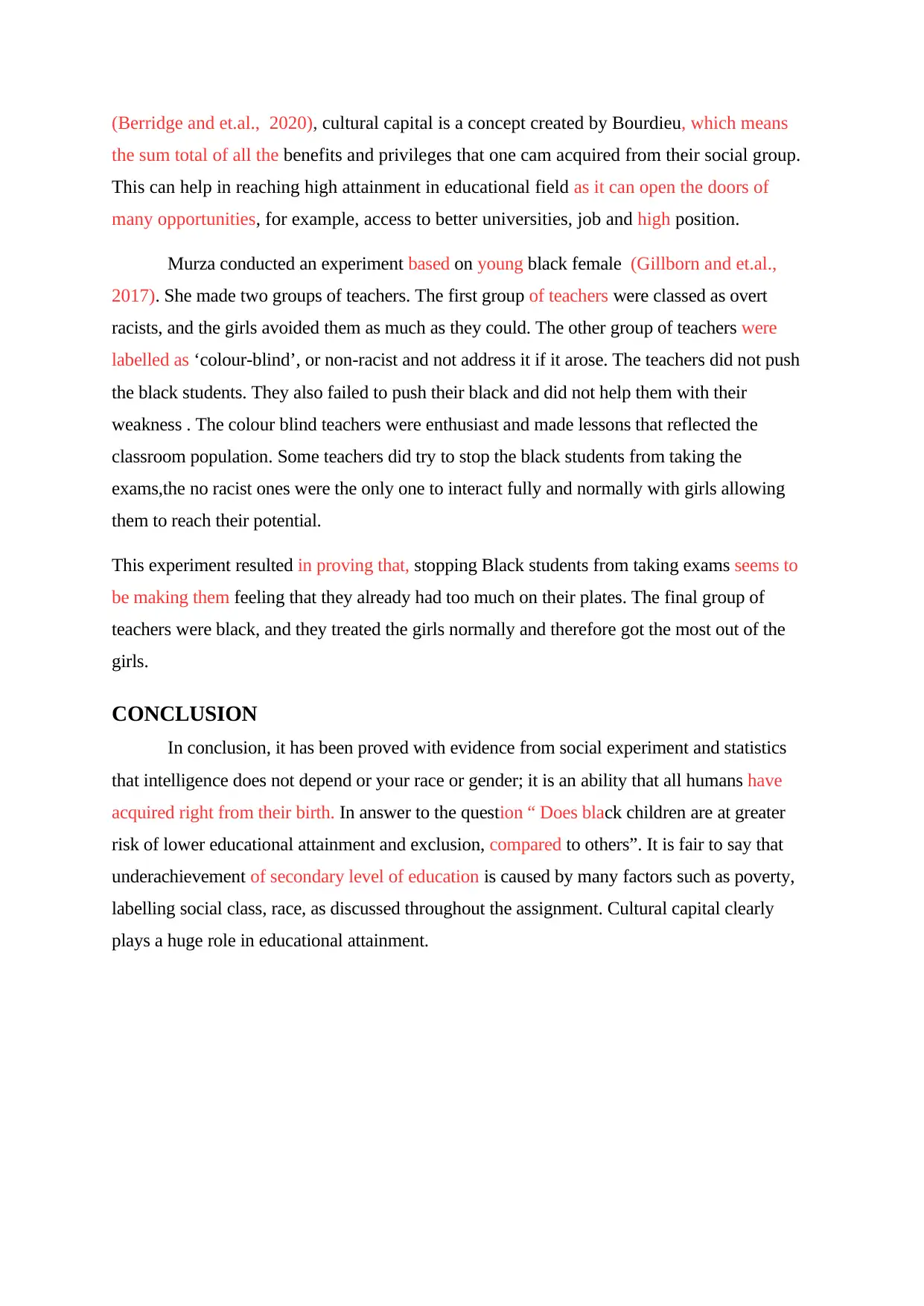
(Berridge and et.al., 2020), cultural capital is a concept created by Bourdieu, which means
the sum total of all the benefits and privileges that one cam acquired from their social group.
This can help in reaching high attainment in educational field as it can open the doors of
many opportunities, for example, access to better universities, job and high position.
Murza conducted an experiment based on young black female (Gillborn and et.al.,
2017). She made two groups of teachers. The first group of teachers were classed as overt
racists, and the girls avoided them as much as they could. The other group of teachers were
labelled as ‘colour-blind’, or non-racist and not address it if it arose. The teachers did not push
the black students. They also failed to push their black and did not help them with their
weakness . The colour blind teachers were enthusiast and made lessons that reflected the
classroom population. Some teachers did try to stop the black students from taking the
exams,the no racist ones were the only one to interact fully and normally with girls allowing
them to reach their potential.
This experiment resulted in proving that, stopping Black students from taking exams seems to
be making them feeling that they already had too much on their plates. The final group of
teachers were black, and they treated the girls normally and therefore got the most out of the
girls.
CONCLUSION
In conclusion, it has been proved with evidence from social experiment and statistics
that intelligence does not depend or your race or gender; it is an ability that all humans have
acquired right from their birth. In answer to the question “ Does black children are at greater
risk of lower educational attainment and exclusion, compared to others”. It is fair to say that
underachievement of secondary level of education is caused by many factors such as poverty,
labelling social class, race, as discussed throughout the assignment. Cultural capital clearly
plays a huge role in educational attainment.
the sum total of all the benefits and privileges that one cam acquired from their social group.
This can help in reaching high attainment in educational field as it can open the doors of
many opportunities, for example, access to better universities, job and high position.
Murza conducted an experiment based on young black female (Gillborn and et.al.,
2017). She made two groups of teachers. The first group of teachers were classed as overt
racists, and the girls avoided them as much as they could. The other group of teachers were
labelled as ‘colour-blind’, or non-racist and not address it if it arose. The teachers did not push
the black students. They also failed to push their black and did not help them with their
weakness . The colour blind teachers were enthusiast and made lessons that reflected the
classroom population. Some teachers did try to stop the black students from taking the
exams,the no racist ones were the only one to interact fully and normally with girls allowing
them to reach their potential.
This experiment resulted in proving that, stopping Black students from taking exams seems to
be making them feeling that they already had too much on their plates. The final group of
teachers were black, and they treated the girls normally and therefore got the most out of the
girls.
CONCLUSION
In conclusion, it has been proved with evidence from social experiment and statistics
that intelligence does not depend or your race or gender; it is an ability that all humans have
acquired right from their birth. In answer to the question “ Does black children are at greater
risk of lower educational attainment and exclusion, compared to others”. It is fair to say that
underachievement of secondary level of education is caused by many factors such as poverty,
labelling social class, race, as discussed throughout the assignment. Cultural capital clearly
plays a huge role in educational attainment.
Paraphrase This Document
Need a fresh take? Get an instant paraphrase of this document with our AI Paraphraser
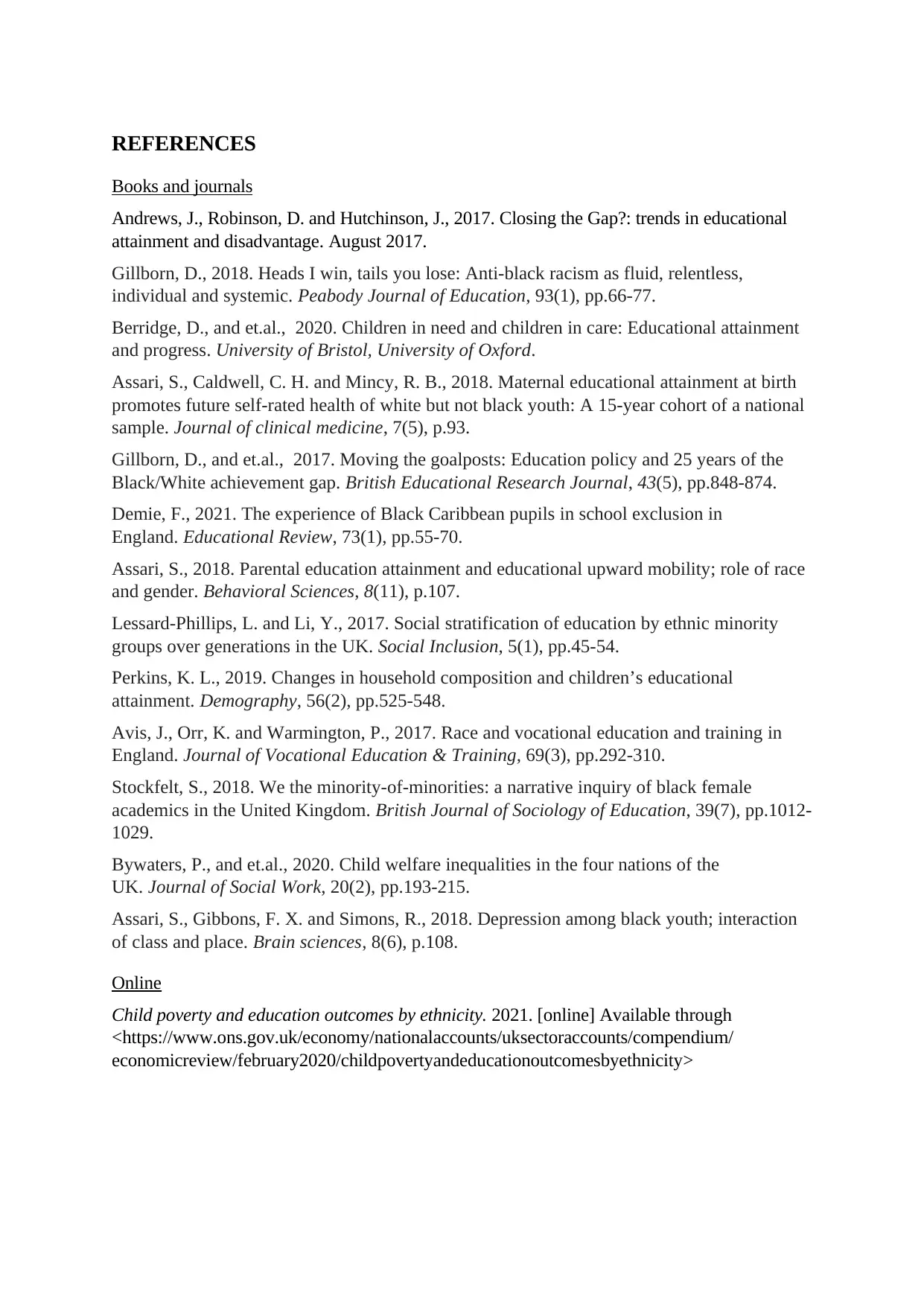
REFERENCES
Books and journals
Andrews, J., Robinson, D. and Hutchinson, J., 2017. Closing the Gap?: trends in educational
attainment and disadvantage. August 2017.
Gillborn, D., 2018. Heads I win, tails you lose: Anti-black racism as fluid, relentless,
individual and systemic. Peabody Journal of Education, 93(1), pp.66-77.
Berridge, D., and et.al., 2020. Children in need and children in care: Educational attainment
and progress. University of Bristol, University of Oxford.
Assari, S., Caldwell, C. H. and Mincy, R. B., 2018. Maternal educational attainment at birth
promotes future self-rated health of white but not black youth: A 15-year cohort of a national
sample. Journal of clinical medicine, 7(5), p.93.
Gillborn, D., and et.al., 2017. Moving the goalposts: Education policy and 25 years of the
Black/White achievement gap. British Educational Research Journal, 43(5), pp.848-874.
Demie, F., 2021. The experience of Black Caribbean pupils in school exclusion in
England. Educational Review, 73(1), pp.55-70.
Assari, S., 2018. Parental education attainment and educational upward mobility; role of race
and gender. Behavioral Sciences, 8(11), p.107.
Lessard-Phillips, L. and Li, Y., 2017. Social stratification of education by ethnic minority
groups over generations in the UK. Social Inclusion, 5(1), pp.45-54.
Perkins, K. L., 2019. Changes in household composition and children’s educational
attainment. Demography, 56(2), pp.525-548.
Avis, J., Orr, K. and Warmington, P., 2017. Race and vocational education and training in
England. Journal of Vocational Education & Training, 69(3), pp.292-310.
Stockfelt, S., 2018. We the minority-of-minorities: a narrative inquiry of black female
academics in the United Kingdom. British Journal of Sociology of Education, 39(7), pp.1012-
1029.
Bywaters, P., and et.al., 2020. Child welfare inequalities in the four nations of the
UK. Journal of Social Work, 20(2), pp.193-215.
Assari, S., Gibbons, F. X. and Simons, R., 2018. Depression among black youth; interaction
of class and place. Brain sciences, 8(6), p.108.
Online
Child poverty and education outcomes by ethnicity. 2021. [online] Available through
<https://www.ons.gov.uk/economy/nationalaccounts/uksectoraccounts/compendium/
economicreview/february2020/childpovertyandeducationoutcomesbyethnicity>
Books and journals
Andrews, J., Robinson, D. and Hutchinson, J., 2017. Closing the Gap?: trends in educational
attainment and disadvantage. August 2017.
Gillborn, D., 2018. Heads I win, tails you lose: Anti-black racism as fluid, relentless,
individual and systemic. Peabody Journal of Education, 93(1), pp.66-77.
Berridge, D., and et.al., 2020. Children in need and children in care: Educational attainment
and progress. University of Bristol, University of Oxford.
Assari, S., Caldwell, C. H. and Mincy, R. B., 2018. Maternal educational attainment at birth
promotes future self-rated health of white but not black youth: A 15-year cohort of a national
sample. Journal of clinical medicine, 7(5), p.93.
Gillborn, D., and et.al., 2017. Moving the goalposts: Education policy and 25 years of the
Black/White achievement gap. British Educational Research Journal, 43(5), pp.848-874.
Demie, F., 2021. The experience of Black Caribbean pupils in school exclusion in
England. Educational Review, 73(1), pp.55-70.
Assari, S., 2018. Parental education attainment and educational upward mobility; role of race
and gender. Behavioral Sciences, 8(11), p.107.
Lessard-Phillips, L. and Li, Y., 2017. Social stratification of education by ethnic minority
groups over generations in the UK. Social Inclusion, 5(1), pp.45-54.
Perkins, K. L., 2019. Changes in household composition and children’s educational
attainment. Demography, 56(2), pp.525-548.
Avis, J., Orr, K. and Warmington, P., 2017. Race and vocational education and training in
England. Journal of Vocational Education & Training, 69(3), pp.292-310.
Stockfelt, S., 2018. We the minority-of-minorities: a narrative inquiry of black female
academics in the United Kingdom. British Journal of Sociology of Education, 39(7), pp.1012-
1029.
Bywaters, P., and et.al., 2020. Child welfare inequalities in the four nations of the
UK. Journal of Social Work, 20(2), pp.193-215.
Assari, S., Gibbons, F. X. and Simons, R., 2018. Depression among black youth; interaction
of class and place. Brain sciences, 8(6), p.108.
Online
Child poverty and education outcomes by ethnicity. 2021. [online] Available through
<https://www.ons.gov.uk/economy/nationalaccounts/uksectoraccounts/compendium/
economicreview/february2020/childpovertyandeducationoutcomesbyethnicity>
1 out of 8
Related Documents
Your All-in-One AI-Powered Toolkit for Academic Success.
+13062052269
info@desklib.com
Available 24*7 on WhatsApp / Email
![[object Object]](/_next/static/media/star-bottom.7253800d.svg)
Unlock your academic potential
Copyright © 2020–2025 A2Z Services. All Rights Reserved. Developed and managed by ZUCOL.





